Environmental enrichment is the process of providing a stimulating environment to promote species-typical behaviour, allow a degree of control and choice in behaviour, and to enhance well-being [1-5]. Environmental complexity and predictability of events are as important as having adequate space [6-9]. A good enrichment programme will incorporate enrichment interventions that satisfy a range of needs in the social, locomotory, sensory, cognitive and food-based domains [10]. Positive interactions with staff may also be considered as enrichment (see Habituation and training).
Why is enrichment important?
The aims of enrichment include [11,12]:
- To improve or maintain an animal’s physical and psychological health.
- To increase the repertoire of species-specific behaviours exhibited.
- To increase utilisation of the captive environment.
- To prevent or reduce the frequency of abnormal and unwanted behaviours, such as stereotypies.
- To increase the individual’s ability to cope with the challenges of living in captivity.
By increasing the complexity of the captive environment, the opportunity for choice also increases. Choice is one way in which captive animals exert control over their environment, their behaviour and their captive situation. Control is an important component of welfare and is linked to predictability, which reduces stress [13].
Designing and implementing enrichment programmes
The S.P.I.D.E.R. Framework, designed by Disney’s Animal Programs, is a simple step-by-step process you can incorporate when designing an enrichment programme [14].
The S.P.I.D.E.R. Framework components
- Brainstorm aspects of best practice you want to achieve / current areas for improvement.
- Enrichment goals may be facility-wide or specific (e.g. targeted to a particular animal or subset of animals).
- Common goals are to: encourage species typical behaviours; prevent or reduce the occurrence of stereotypical behaviours; increase the amount of choice animals have in their interactions with their environment.
- The Disney site has a list questions to consider when setting enrichment goals.
- Consider the behaviour and ecological niche of the species [15].
- Identify intended outcomes of the programme – this will help to determine which measures to use to assess its effectiveness.
- You should now have agreement on the natural history, individual animal history, research and husbandry constraints, intended outcomes and how to measure them.
- Create an enrichment plan that is agreeable to all parties. Changes can be kept small to begin with.
- Remember that the long-term benefits of enrichment will likely outweigh short-term interruptions to laboratory routines.
- It is essential at this stage to have good communication between everyone involved.
- Consider individual needs – different animals may not benefit from each enrichment item in the same way [16]. Some animals may require more or less stimulation. Animals which often display signs of stress and stereotypy may need more directed enrichment than other animals.
- Consider accessibility to items – high ranking animals are more likely to gain access to desirable enrichment items (e.g. feeding items) than low ranking animals, so multiple items may need to be provided, and in different locations, to avoid hoarding [17].
- Make sure you have clarified who will do what and when:
- Who will make and give the enrichments?
- Who will monitor enrichment use and outcomes?
- Who will be responsible for assessing effectiveness of the intervention, or end it if safety concerns arise?
- Provide a variety of enrichment items simultaneously [18].
- Organise a roster for the provision of enrichment, so enrichment items are rotated and the animals don’t get bored.
- The Disney site shows a roster in the form of a ‘month at a glance enrichment calendar‘.
- The roster should be based on the number and type of enrichment items, the number of animals, the needs of the animals, and their interest in the items. For example:
- Structural enrichment items will be alternated every 2 weeks.
- Destructible items, such as cardboard boxes, will be removed every 2 days.
- Food enrichment items will be changed daily.
- Documenting which animals use which enrichments, when, where and for how long will help to assess the effectiveness of the enrichment programme and to refine it [15].
- Recording may be done simply and quickly as brief notes on main events as part of daily checks/husbandry, a more systematic ‘tick sheet’ approach, or using traditional behavioural monitoring techniques (see Recording behaviour) which are more time consuming but provide rich data.
- Evaluate the effectiveness of the programme by comparing the records for before, during and after provision of the enrichment items.
- Simple statistical tests can be used to determine whether any changes are significant [19].
Enrichment safety considerations
The potential dangers of any enrichment item should be carefully considered and assessed before incorporating these stimuli into your enrichment program [11].
Safety precautions to consider include the following:
- Choking hazards.
- Strangling hazards.
- Transmission of disease.
- Parts that can be used as weapons.
- The temperament, age, sex or past experience of the animals [15,22-24].
- Detrimental psychological effects, such as fear [25].
Also see Enrichment gone wrong!
The Shape of Enrichment website has a searchable ‘Safety Database’, providing information on potentially dangerous enrichment items.
Always observe animals with any new enrichment items to ensure that there are no dangers and to be able to intervene quickly if necessary.
-
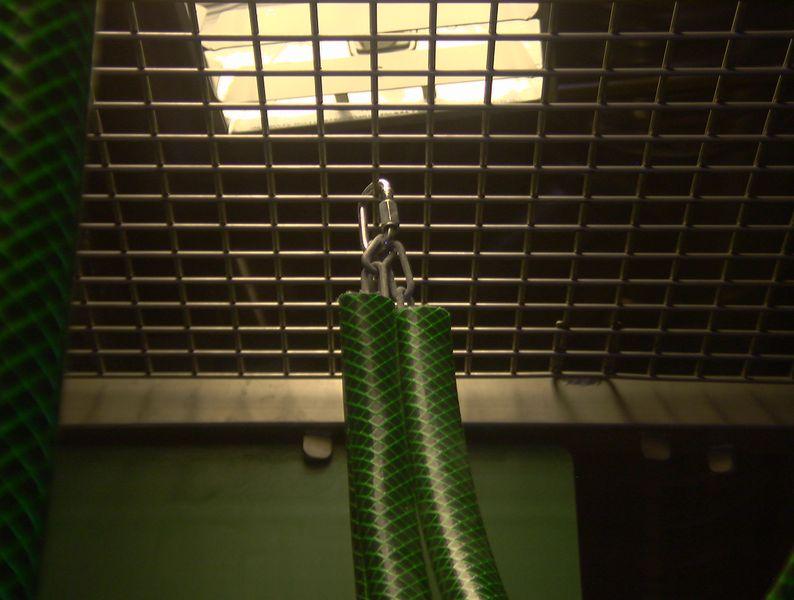 Enrichment hanging from mesh ceiling
Enrichment hanging from mesh ceiling
Suitable objects to provide structure to enclosures include ladders, barrels, tyres, swings, hammocks, platforms, shelves, logs and branches. Such objects need to be attached securely within the enclosure, as the monkeys will jump onto them with force. Some studies suggest that adult macaques may prefer fixed structures to moveable ones [48-51]. It is preferable to use wood, where possible, as it is a softer material than metal or plastic, and can be gnawed.
Below you can find a range of suggested 'recipes' to provide structural enrichment.
-
Vertical hanging items act as visual barriers enabling some privacy.
-
Suspended tyres provide additional resting areas and places to hide.
-
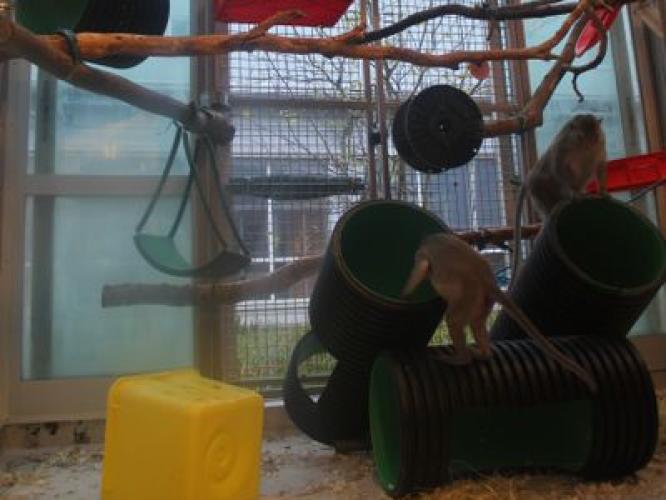 A good amount of structural enrichment
A good amount of structural enrichment -
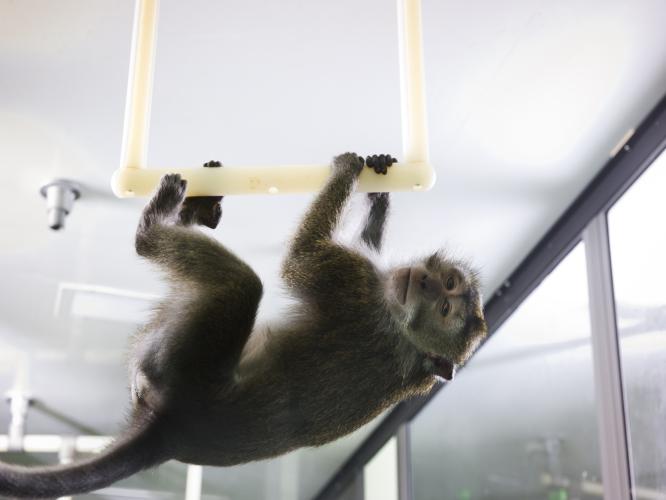 A cynomolgus macaque hangs upside down on a perch
A cynomolgus macaque hangs upside down on a perch
Recipe for suspended pipe 1
Materials
- 1 strip of fire hose
- 1 carabiner
- 1 length of PVC pipe
- 1 metal ceiling hook/ring
Construction
- Drill a large hole through the piping to thread the fire hose through.
- The length of the fire hose used will determine how low the structure will hang.
- The structure can also be hung off the underside of wooden platforms.
- Plastic balls can also be hung from the end of the pipe.
-
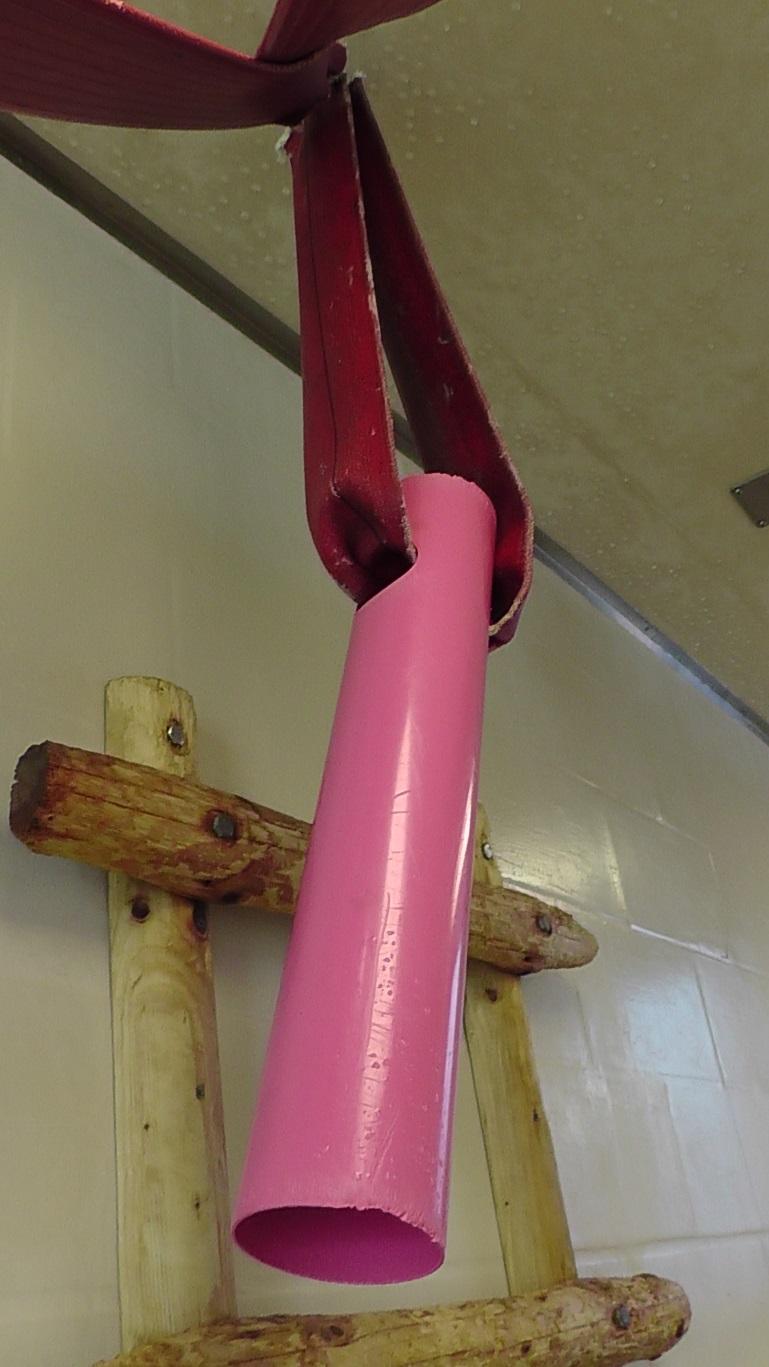 PVC pipe (Image: C Kemp/MRC Centre for Macaques)
PVC pipe (Image: C Kemp/MRC Centre for Macaques) -
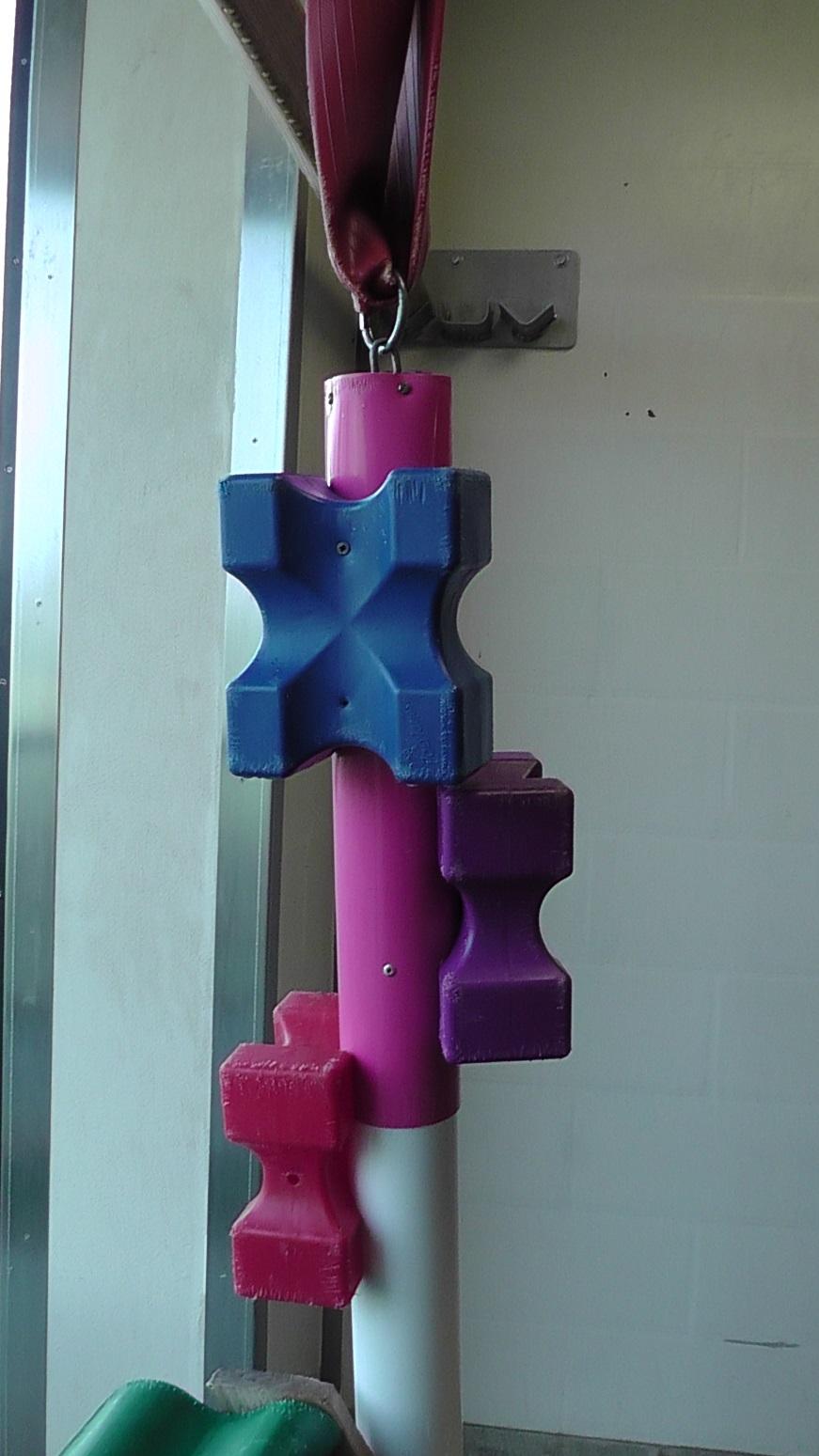 PVC pipe with blocks (Image: C Kemp/MRC Centre for Macaques)
PVC pipe with blocks (Image: C Kemp/MRC Centre for Macaques)
Recipe for suspended pipe 2
Materials
- 1 length of PVC pipe
- 1 carabiner
- 1 length of fire hose
- Bolts/screws
- Small plastic horse blocks
Construction
- Attach several plastic blocks along the length of the PVC pipe at two points for stability
- Drill holes into the plastic block to allow water to drain during cleaning
- The PVC pipe can be hung using rings which can then be attached to fire hose and hung in the housing
- The plastic blocks can also be attached to other substrates, including wooden poles and the walls to create alternate climbing frames
Recipe for fire hose swings/climbing structures
Materials
- Lengths of fire hose
- Carabiners
- Ceiling plate hooks
- Metal rings
Construction
- Use different lengths of hose to connect different points of the housing and create climbing pathways with different tension.
- Cut holes into the ends of the fire hose with enough room to allow for tearing from general use.
- Several lengths of fire hose can be attached to the same point using carabiners.
Recipe for horse jump climbing structures
Materials
- Plastic horse jumps
- Flat wood planks
- Wooden poles
- Strips of fire hose
- Stainless steel pole base plates
- Long bolts/screws
Construction
- There are a variety of ways in which the plastic horse jumps can be put together
- Distance between the horse jumps will depend on the length of the wooden planks and poles – be creative by playing with this distance for a range of structures
- Using fire hose improves the grip of the bolts and reduces the chances the monkeys can pull them out
- Attaching the wooden pole on the metal base plate increases the height of the structure and provides stability to a round object
- Drill holes into the horse jumps to allow water to drain after cleaning
- Using hardwood will ensure that this structure is long lasting, reducing wear from chewing and water rot
- Plastic balls and blocks can also be attached to these structures for variety
-
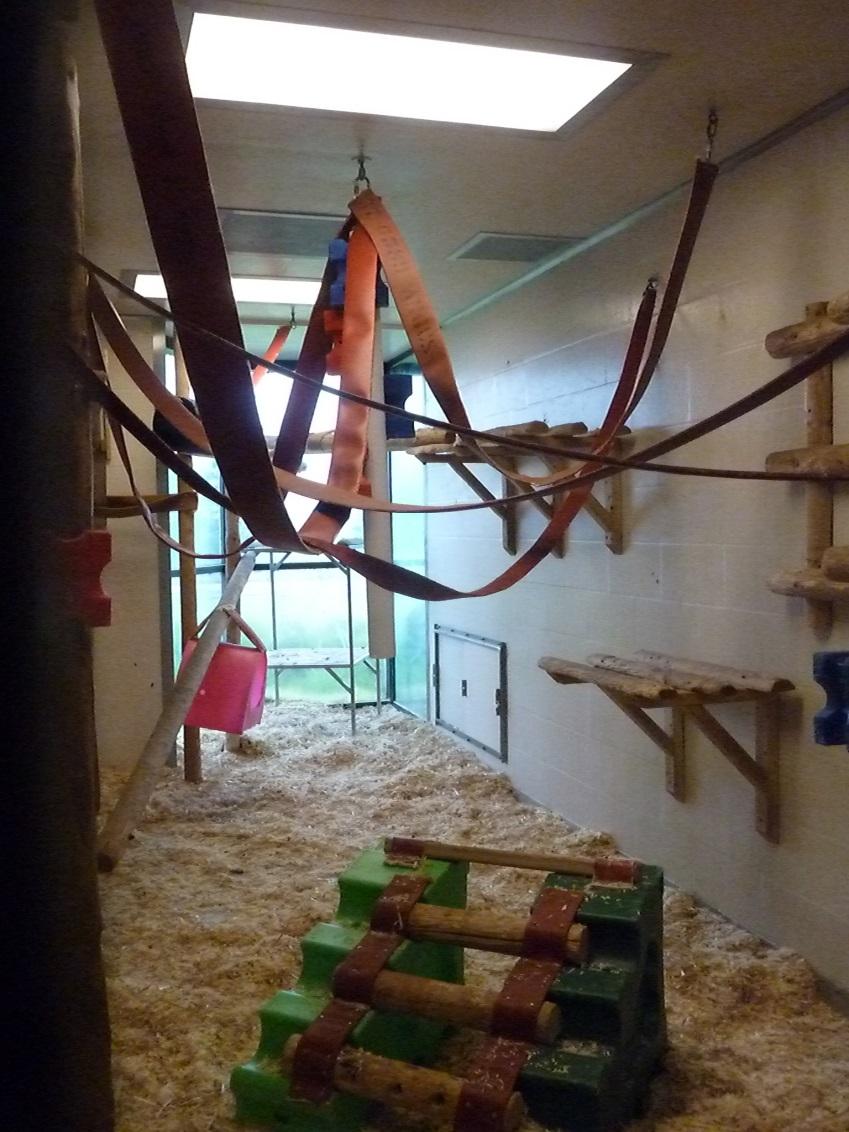 An example of an indoor enclosure (Image: C Kemp/MRC Centre for Macaques)
An example of an indoor enclosure (Image: C Kemp/MRC Centre for Macaques) -
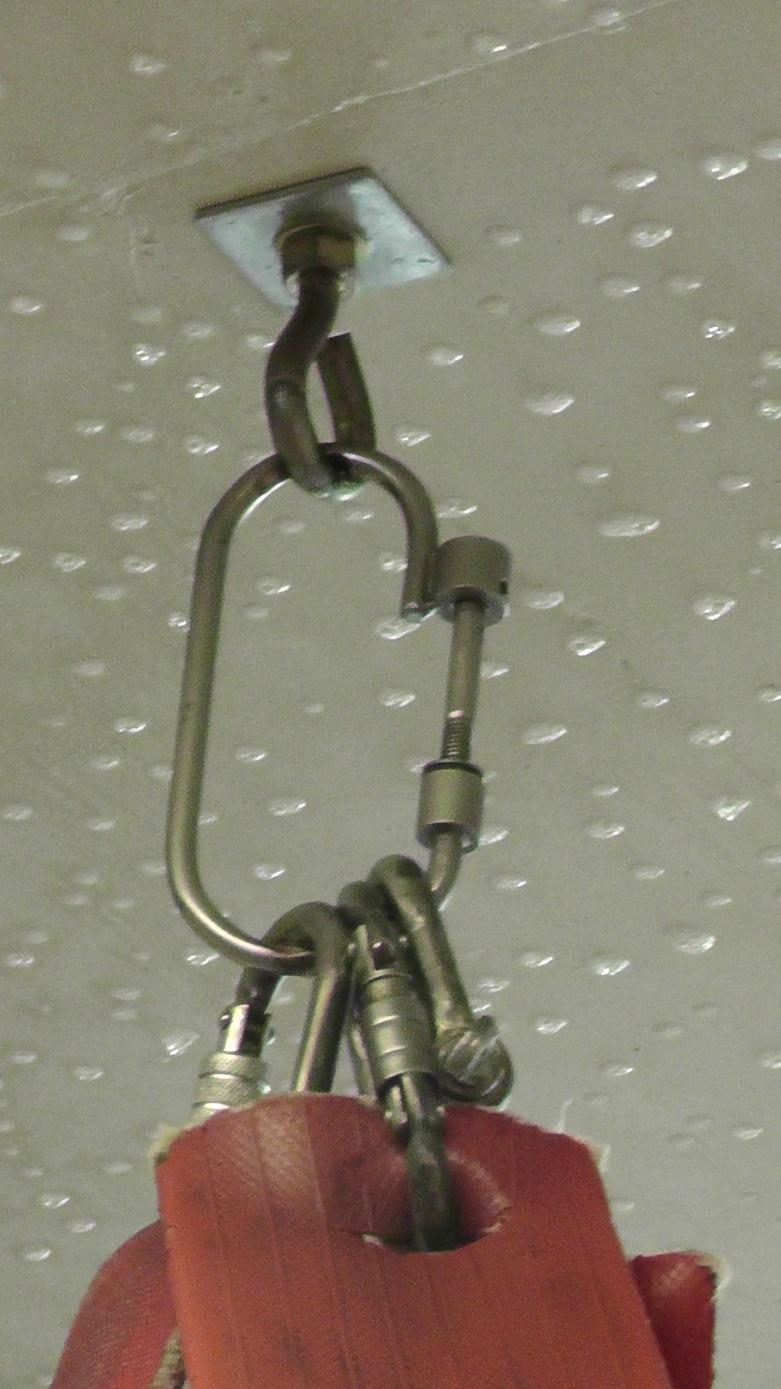 Fixing point (Image: C Kemp/MRC Centre for Macaques)
Fixing point (Image: C Kemp/MRC Centre for Macaques)
Recipe for toy swings
Materials
- Length of fire hose
- Carabiners
- Hooks and rings
- Plastic barrels
- Plastic crates
- Plastic balls
Construction
- Attach one end of the fire hose to the wall/ceiling/sturdy platform first, then loop it through a barrel or large plastic box and attach the other end
- Barrels, crates and boxes can also be attached to just one end of the fire hose using a carabiner and allowed to swing freely
- Drill holes into the bottom of the plastic barrels/boxes/crates/balls to create a drainage point
-
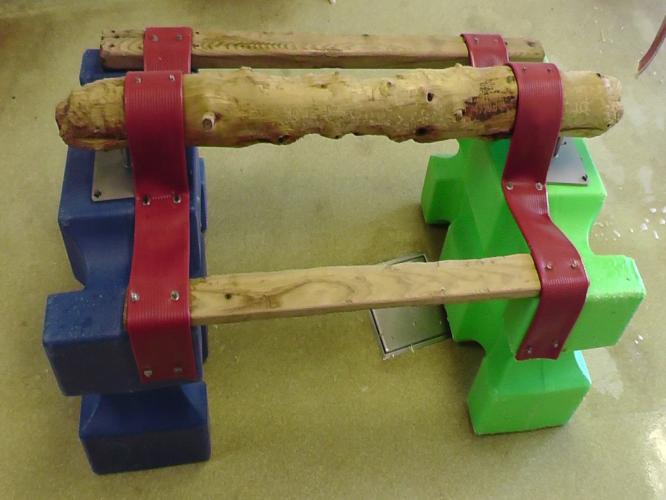 Horse jumps connected (Image: C Kemp/MRC Centre for Macaques)
Horse jumps connected (Image: C Kemp/MRC Centre for Macaques) -
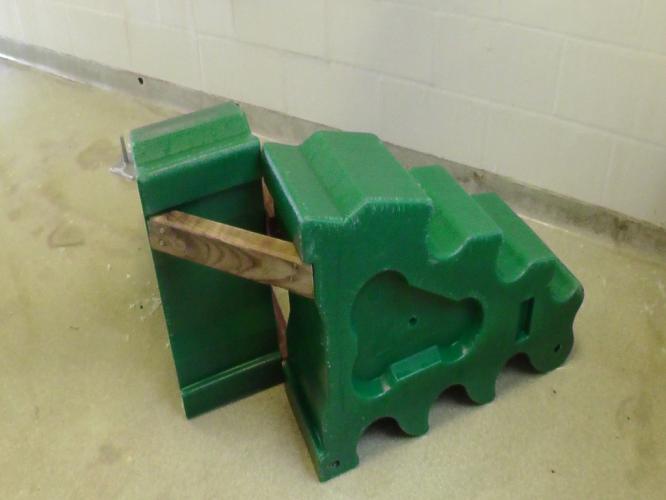 Horse jump (Image: C Kemp/MRC Centre for Macaques)
Horse jump (Image: C Kemp/MRC Centre for Macaques) -
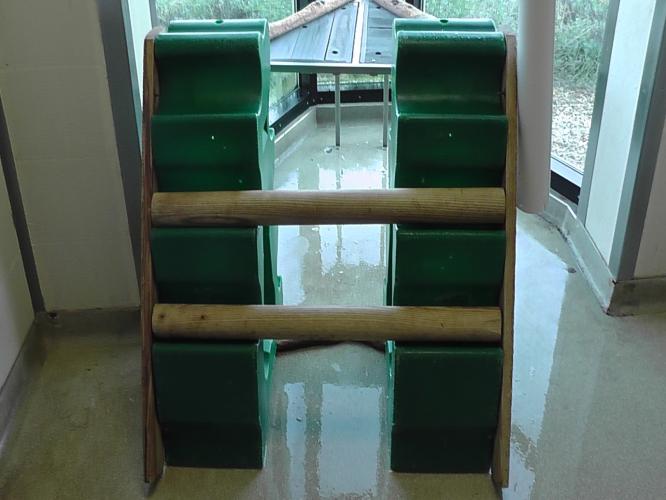 Horse jumps connected (Image: C Kemp/MRC Centre for Macaques)
Horse jumps connected (Image: C Kemp/MRC Centre for Macaques)
Recipe for suspended tyres
Materials
- Forklift tyres
- Fire hose
- Carabiners
- Ceiling hooks
- Metal rings
- Hardwood planks
- Chain
Construction
- Tyres can be hung as a swing or anchored upright on the floor
- Use fire hose or chain with a carabiner to hang the tyre from the ceiling
- Link tyres together to make a ladder or chain
- Wood can be bolted onto an upright tyre to maintain its position and create stability
Providing food as a single meal on a predictable schedule, or as easy to process food items in one location (e.g pellets in a hopper), ignores the complex behaviour and cognition associated with feeding, and may have adverse consequences for animal welfare. Appropriate nutrition is clearly essential (see Feeding), but providing variety in the content of the diet and in the method of food presentation will enrich the lives of captive macaques [12].
- Create foraging opportunities which increase the time and effort required for retrieval of food. This will help stimulate natural foraging behaviour, as well as cognitive processes, and acts as a reward mechanism [72].
Examples include:- Scattering food amongst a substrate, such as woodwool or sawdust, either on the floor or inside a paper bag [74].
- Feeding a very fine forage mix (e.g. a mixture of peanuts in the shell, sunflower seeds, pumpkin seeds, pine kernels, flaked maize, locust beans, banana chips, dried apricots, raisins, rice grains).
- Putting food items inside containers, either stoppered with something easy-to-remove (e.g. woodwool) or with a lid that must be peeled or screwed off.
- Utilising puzzle feeders, which require manipulation and the development of fine motor skills for retrieval of food [75,76].
- Suspending food (e.g. browse) within the enclosure; this will make feeding more challenging and introduce unpredictable movement to the process.
- Spread out feeding over a number of times during the day.
- Vary the types of food provided per day and between days.
- Provide whole food items that require manipulation and processing, as well as food cut into smaller portions.
- Smear sticky foods (e.g. honey, apple syrup) on surfaces, such as toys or objects which can be hung from the outside of the enclosure or climbing surfaces. Tennis balls can be rolled in syrup or diluted fruit juices, and then into forage mix.
- Feed live insects. Mealworms are commonly given to captive monkeys, but crickets are also a great source of feeding enrichment as the monkeys must work harder to catch them.
- Freeze liquids, such as fruit juice or diluted yoghurt, into blocks. Kong toys can also be filled with food (e.g. peanuts, fruit, sunflower seeds) and frozen.
-
Cynomolgus macaque with whole pumpkin.JPG
-
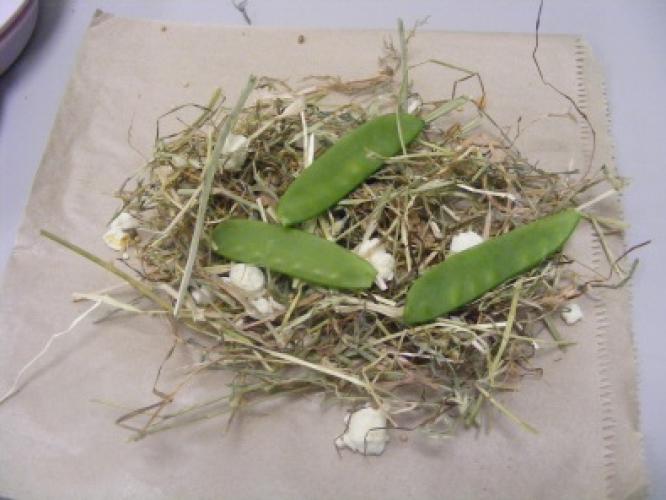 Packet of forage wrapped in paper
Packet of forage wrapped in paper -
macaque manipulating and eating whole sweetcorn
-
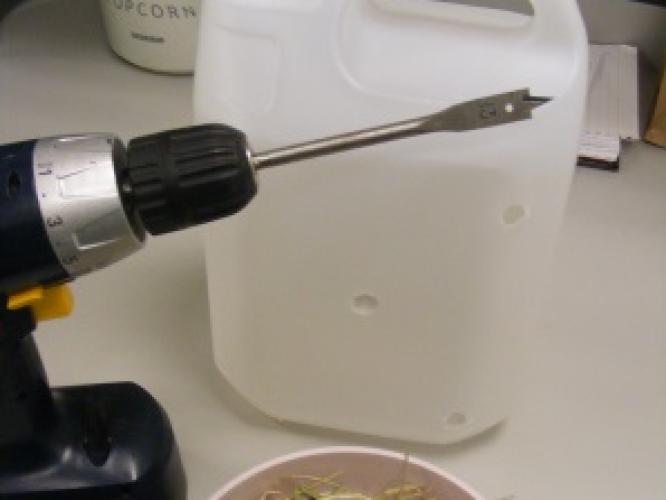 Foraging puzzle made from a plastic container
Foraging puzzle made from a plastic container
While many novel enrichment items are often presented with food to ease any uncertainty regarding their presentation, it is important to note that not all enrichment items need to be associated with food in order to elicit interest. If an enrichment item is utilised by the macaques without the presence of food, it is recommended that any association with food is avoided if it is suspected that the use of the item would decrease or stop after presentation with food.
Recipe for a low calorie forage mix
Ingredients
- Millet seeds – 5 cups
- Hemp seeds – 3 cups
- Rice – 3 cups
- Sesame seeds – 2 cups
- Split peas or similar – 1/2 cup
- Sunflower or pumpkin seeds – 1/2 cup
Notes
- A low calorie, fine forage mix is useful for promoting calm foraging behaviour in groups of macaques housed indoors, even those whose main diet is controlled for a research purpose or health reasons (e.g. obesity)
- 10g per animal (approx. 35 calories) can be scattered into floor substrate once or twice per day
-
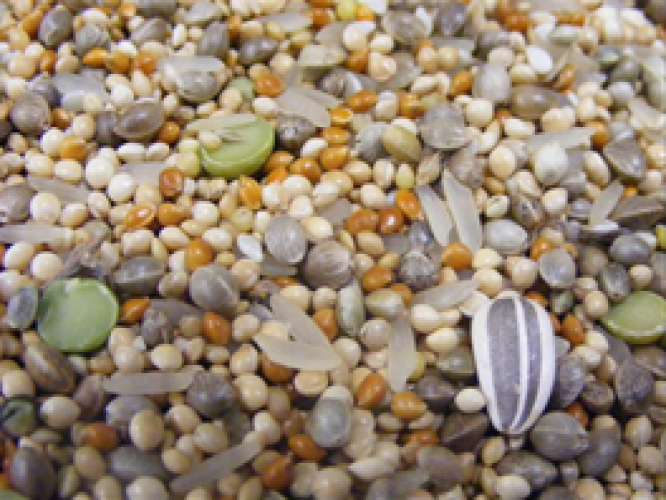 Forage mix 3
Forage mix 3 -
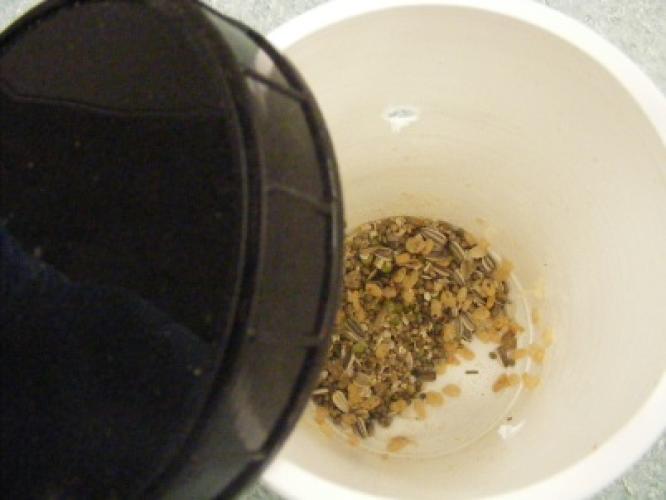 Forage mix 2
Forage mix 2 -
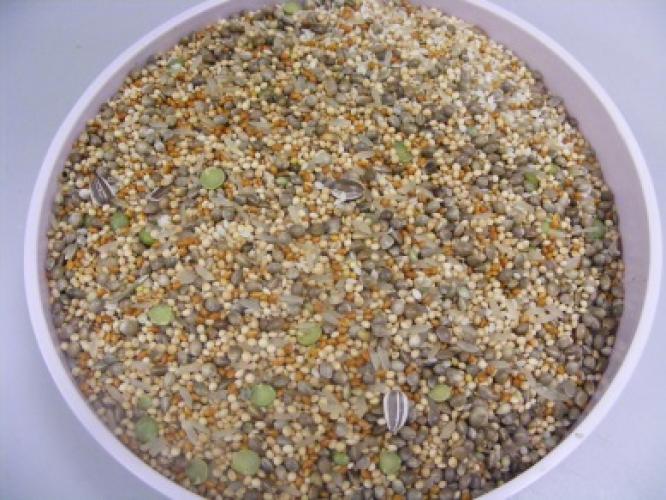 Forage mix 1
Forage mix 1
Recipe for a forage mix
Ingredients
- Porridge oats
- Marrowfat peas
- Red lentils
- Bran flakes
- Mustard seeds
- Safflower seeds
- Millet
- Bulgar wheat
- Barley
- Desiccated coconut
- Irradiated wheat
- Linseed
- Caraway seeds
- Coriander
- Long grain rice
- Cornflakes
- Popcorn
- Sunflower seeds
- Buckwheat
- Beans
- Dun peas
- Maple peas
- French maize
- Yellow peas
- Dried green peas
- Cabbage seed
- Red dari
- White dari
Notes
- Some of these ingredients can be found pre-mixed in pigeon seed.
- Mix up different combinations for variety
- Forage mix can be used as part of the daily diet (thrown into foraging substrate) or can be used in other types of food enrichment (see below)
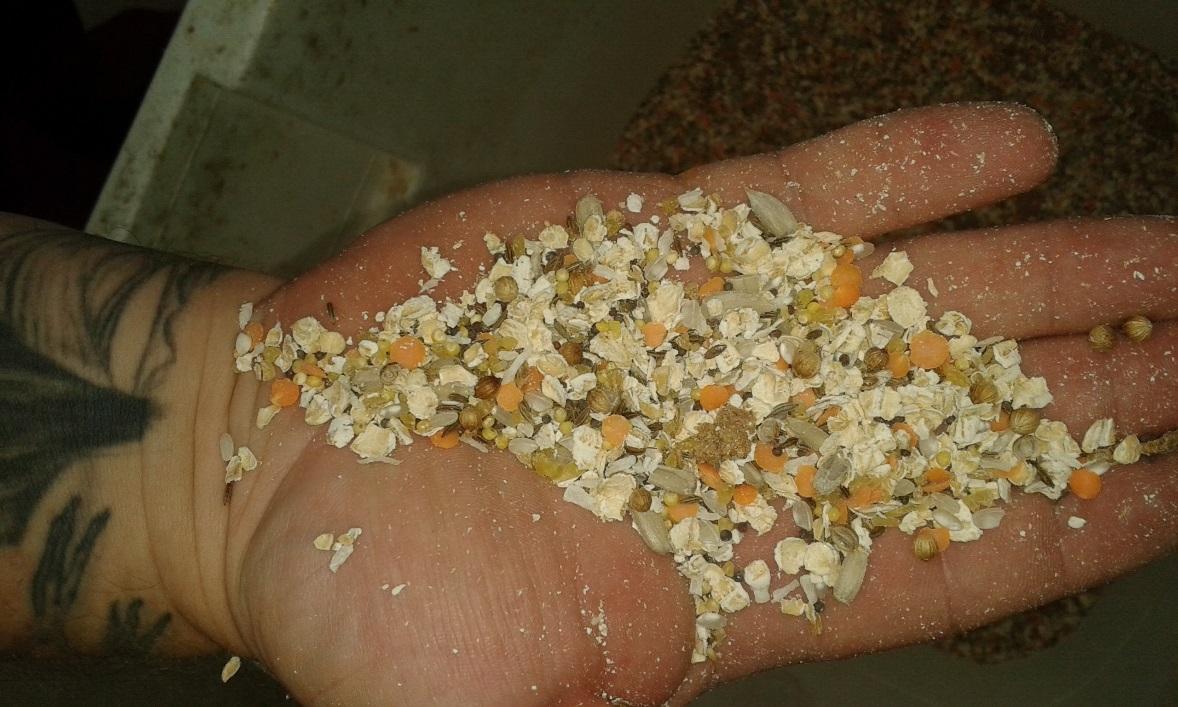
Recipe for forage bags/packets
Ingredients
- Paper bags (various sizes)
- Forage mix
- Straw/shredded paper
Notes
- Ensure that the bags have no staples
- Stuff the bags with straw/shredded paper and place a handful of forage mix inside
- Roll the bags up tightly so that the monkeys must work a little to open them
- Ensure that you have enough bags for the number of monkeys to avoid fights
- Place the bags around the housing and find hiding places
References
-
Maple TL and Stine WW (1982). Environmental variables and great ape husbandry. American Journal of Primatology 3(S1): 67-76. https://doi.org/10.1002/ajp.1350030513
-
Wilson SF (1982). Environmental influences on the activity of captive apes. Zoo Biology 1(3): 201-9. https://doi.org/10.1002/zoo.1430010304
-
Perkins LA (1992). Variables that influence the activity of captive orangutans. Zoo Biology 11(3): 177-86. https://doi.org/10.1002/zoo.1430110306
-
Newberry RC (1995). Environmental enrichment: Increasing the biological relevance of captive environments. Applied Animal Behaviour Science 44(2-4): 229-43. https://doi.org/10.1016/0168-1591(95)00616-Z
-
Shepherdson DJ (1998). Tracing the path of environmental enrichment in zoos`. In: Second nature: Environmental enrichment for captive animals (Eds. Shepherdson DJ, Mellen JD, and Hutchins M) (pp. 1-12). Smithsonian Institution Press.
-
Kerl J and Roth H (1996). Influence of cage size and cage equipment on physiology and behavior of common marmosets (callithrix jacchus). Laboratory Primate Newsletter 35(3): 10-3.
-
Kitchen AM and Martin AA (1996). The effects of cage size and complexity on the behaviour of captive common marmosets, callithrix jacchus jacchus. Laboratory Animals 30(4): 317-26. https://doi.org/10.1258/002367796780739853
-
Jensvold MLA et al. (2001). Effect of enclosure size and complexity on the behaviors of captive chimpanzees (pan troglodytes). Journal of Applied Animal Welfare Science 4(1): 53-69. https://doi.org/10.1207/S15327604JAWS0401_3
-
Bassett L and Buchanan-Smith HM (2007). Effects of predictability on the welfare of captive animals. Applied Animal Behaviour Science 102(3-4): 223-45. https://doi.org/10.1016/j.applanim.2006.05.029
-
Buchanan-Smith HM (2010). Environmental enrichment for primates in laboratories. Advances in Science and Research 5(1): 41-56. https://doi.org/10.5194/asr-5-41-2010
-
Young RJ (2003). Environmental enrichment for captive animals. Blackwell Science.
-
Jennings M et al. (2009). Refinements in husbandry, care and common procedures for non-human primates. Laboratory Animals 43(1_suppl): 1-47. https://doi.org/10.1258/la.2008.007143
-
Sambrook TD and Buchanan-Smith HM (1996). What makes novel objects enriching? A comparison of the qualities of control and complexity. Laboratory Primate Newsletter 35(4): 1-4.
-
Colahan H and Breder C (2003). Primate training at disney's animal kingdom. Journal of Applied Animal Welfare Science 6(3): 235-46. https://doi.org/10.1207/S15327604JAWS0603_08
-
Lutz CK and Novak MA (2005). Environmental enrichment for nonhuman primates: Theory and application. ILAR Journal 46(2): 178-91. https://doi.org/10.1093/ilar.46.2.178
-
Buchanan-Smith HM (2010). Environmental enrichment for primates in laboratories. Advances in Science and Research 5(1): 41-56. https://doi.org/10.5194/asr-5-41-2010
-
Bloomstrand M et al. (1986). Objective evaluation of a behavioral enrichment device for captive chimpanzees (pan troglodytes). Zoo Biology 5(3): 293-300. https://doi.org/10.1002/zoo.1430050307
-
Schapiro SJ and Bloomsmith MA (1995). Behavioral effects of enrichment on singly-housed, yearling rhesus monkeys: An analysis including three enrichment conditions and a control group. American Journal of Primatology 35(2): 89-101. https://doi.org/10.1002/ajp.1350350202
-
Baker KC et al. (2014). Comparing options for pair housing rhesus macaques using behavioral welfare measures. American Journal of Primatology 76(1): 30-42. https://doi.org/10.1002/ajp.22190
-
Crockett C et al. (1989). Kong toys as enrichment devices for singly-caged macaques. Laboratory Primate Newsletter 28: 21-2.
-
Kessel AL and Brent L (1998). Cage toys reduce abnormal behavior in individually housed pigtail macaques. Journal of Applied Animal Welfare Science 1(3): 227-34. https://doi.org/10.1207/s15327604jaws0103_3
-
Reinhardt V and Reinhardt A (2008). Environmental enrichment and refinement for nonhuman primates kept in research laboratories: A photographic documentation and literature review. Animal Welfare Institute.
-
Novak MA et al. (1993). Old, socially housed rhesus monkeys manipulate objects. Zoo Biology 12(3): 285-98. https://doi.org/10.1002/zoo.1430120306
-
Parks KA and Novak MA (1993). Observations of increased activity and tool use in captive rhesus monkeys exposed to troughs of water. American Journal of Primatology 29(1): 13-25. https://doi.org/10.1002/ajp.1350290103
-
Hoy JM et al. (2009). Thirty years later: Enrichment practices for captive mammals. Zoo Biology 29(3): 303-16. https://doi.org/10.1002/zoo.20254
-
Lindburg DG (1971). The rhesus monkey in north india : An ecological and behavioral study. In: Primate behavior: Developments in field and laboratory research (Ed., Rosenblum LA) (Vol. 2, pp. 1-106). Academic Pr.
-
Hutchins M and Barash DP (1976). Grooming in primates: Implications for its utilitarian function. Primates 17: 145-50.
-
Reinhardt V (1989). Behavioral responses of unrelated adult male rhesus monkeys familiarized and paired for the purpose of environmental enrichment. American Journal of Primatology 17(3): 243-8. https://doi.org/10.1002/ajp.1350170305
-
Gust DA et al. (1994). Effect of a preferred companion in modulating stress in adult female rhesus monkeys. Physiology & Behavior 55(4): 681-4. https://doi.org/10.1016/0031-9384(94)90044-2
-
Sackett GP et al. (1981). Social isolation rearing effects in monkeys vary with genotype. Developmental Psychology 17(3): 313-8. https://doi.org/10.1037/0012-1649.17.3.313
-
Line SW et al. (1991). Simple toys do not alter the behavior of aged rhesus monkeys. Zoo Biology 10(6): 473-84. https://doi.org/10.1002/zoo.1430100606
-
Novak MA et al. (1993). Old, socially housed rhesus monkeys manipulate objects. Zoo Biology 12(3): 285-98. https://doi.org/10.1002/zoo.1430120306
-
Reinhardt V and Reinhardt A (2002). Comfortable quarters for primates in research institutions. Animal Welfare Institute.
-
Roberts SJ and Platt ML (2005). Effects of isosexual pair-housing on biomedical implants and study participation in male macaques. JAALAS(6): 13-8.
-
Reinhardt V et al. (1995). Social housing of previously single-caged macaques: What are the options and the risks? Animal Welfare 4(4): 307-28.
-
Watson LM (2002). A successful program for same- and cross-age pair-housing adult and subadult male macaca fasicularis. Laboratory Primate Newsletter 41: 6-9.
-
Turner PV et al. (2003). Refinements in the care and use of animals in toxicology studies—regulation, validation, and progress. JAALAS 42(6): 8-15.
-
DiVincenti Jr L and Wyatt JD (2011). Pair housing of macaques in research facilities: A science-based review of benefits and risks. JAALAS 50(6): 856-63.
-
Crockett CM et al. (1997). Grooming-contact bars provide social contact for individually caged laboratory macaques. JAALAS 36(6): 53-60.
-
Carlson J (2008). Safe pair housing of macaques. Animal Welfare Institute.
-
Rennie AE and Buchanan-Smith HM (2006). Refinement of the use of non-human primates in scientific research. Part ii: Housing, husbandry and acquisition. Animal Welfare. https://www.researchgate.net/publication/228670741
-
Baker KC et al. (2014). Comparing options for pair housing rhesus macaques using behavioral welfare measures. American Journal of Primatology 76(1): 30-42. https://doi.org/10.1002/ajp.22190
-
Visalberghil E and Anderson JR (1993). Reasons and risks associated with manipulating captive primates' social environments. Animal Welfare 13: 3-15.
-
Hartner M et al. (2001). Group-housing subadult male cynomolgus macaques in a pharmaceutical environment. Laboratory Animals 8: 53-7.
-
Wolfensohn S (2004). Social housing of large primates: Methodology for refinement of husbandry and management. Alternatives to Laboratory Animals 32(1_suppl): 149-51. https://doi.org/10.1177/026119290403201s24
-
McCowan B et al. (2008). Utility of social network analysis for primate behavioral management and well-being. Applied Animal Behaviour Science 109(2-4): 396-405. https://doi.org/10.1016/j.applanim.2007.02.009
-
Reinhardt V (1994). Pair-housing rather than single-housing for laboratory rhesus macaques. Journal of Medical Primatology 23(8): 426-31. https://doi.org/10.1111/j.1600-0684.1994.tb00131.x
-
Bryant CE et al. (1988). Effects of different environmental enrichment devices on cage stereotypies and autoaggression in captive cynomolgus monkeys. Journal of Medical Primatology 17(5): 257-69. https://doi.org/10.1111/j.1600-0684.1988.tb00388.x
-
Kopecky J and Reinhardt V (1991). Comparing the effectiveness of pvc swings versus pvc perches as environmental enrichment objects for caged female rhesus macaques (macaca mulatta). Laboratory Primate Newsletter 30(2): 5-6.
-
Dexter SL and Bayne K (1994). Results of providing swings to individually housed rhesus monkeys (macaca mulatta). Laboratory Primate Newsletter 33(2): 9-12.
-
Reinhardt V and Reinhardt A (2008). Environmental enrichment and refinement for nonhuman primates kept in research laboratories: A photographic documentation and literature review. Animal Welfare Institute.
-
Wells DL (2009). Sensory stimulation as environmental enrichment for captive animals: A review. Applied Animal Behaviour Science 118(1-2): 1-11. https://doi.org/10.1016/j.applanim.2009.01.002
-
Butler RA (1954). Incentive conditions which influence visual exploration. Journal of Experimental Psychology 48(1): 19-23. https://doi.org/10.1037/h0063578
-
Butler RA (1958). The differential effect of visual and auditory incentives on the performance of monkeys. The American Journal of Psychology 71(3): 591-. https://doi.org/10.2307/1420258
-
Butler RA (1961). The responsiveness of rhesus monkeys to motion pictures. The Journal of Genetic Psychology 98(2): 239-45. https://doi.org/10.1080/00221325.1961.10534374
-
Platt DM and Novak MA (1997). Videostimulation as enrichment for captive rhesus monkeys (macaca mulatta). Applied Animal Behaviour Science 52(1-2): 139-55. https://doi.org/10.1016/S0168-1591(96)01093-3
-
Swartz KB and Rosenblum LA (1980). Operant responding by bonnet macaques for color videotape recordings of social stimuli. Animal Learning & Behavior 8(2): 311-21. https://doi.org/10.3758/BF03199611
-
Haude RH and Detwiler DH (1976). Visual observing by rhesus monkeys: Influence of potentially threatening stimuli. Perceptual and Motor Skills 43(1): 231-7. https://doi.org/10.2466/pms.1976.43.1.231
-
Pfingst BE et al. (1978). Pure tone thresholds for the rhesus monkey. Hearing Research 1(1): 43-7. https://doi.org/10.1016/0378-5955(78)90008-4
-
Line SW et al. (1990). Responses of female rhesus macaques to an environmental enrichment apparatus. Laboratory Animals 24(3): 213-20. https://doi.org/10.1258/002367790780866245
-
Howell S et al. (2003). A stereo music system as environmental enrichment for captive chimpanzees. Lab Animal 32(10): 31-6. https://doi.org/10.1038/laban1103-31
-
Ogden JJ et al. (1994). A preliminary study of the effects of ecologically relevant sounds on the behaviour of captive lowland gorillas. Applied Animal Behaviour Science 39(2): 163-76. https://doi.org/10.1016/0168-1591(94)90136-8
-
Patterson-Kane EG and Farnworth MJ (2006). Noise exposure, music, and animals in the laboratory: A commentary based on laboratory animal refinement and enrichment forum (laref) discussions. Journal of Applied Animal Welfare Science 9(4): 327-32. https://doi.org/10.1207/s15327604jaws0904_7
-
Laska M (2000). 'Microsmatic' primates revisited: Olfactory sensitivity in the squirrel monkey. Chemical Senses 25(1): 47-53. https://doi.org/10.1093/chemse/25.1.47
-
Anderson JR et al. (1992). Task-directed and recreational underwater swimming in captive rhesus monkeys (macaca mulatta). Laboratory Primate Newsletter 31(4): 1-4.
-
Anderson JR et al. (1994). Diving and underwater swimming as enrichment activities for captive rhesus macaques (macaca mulatta). Animal Welfare 3(4): 275-83.
-
Parks KA and Novak MA (1993). Observations of increased activity and tool use in captive rhesus monkeys exposed to troughs of water. American Journal of Primatology 29(1): 13-25. https://doi.org/10.1002/ajp.1350290103
-
Robins JG and Waitt CD (2011). Improving the welfare of captive macaques (macaca sp) through the use of water as enrichment. Journal of Applied Animal Welfare Science 14(1): 75-84. https://doi.org/10.1080/10888705.2011.527605
-
Whitehouse J et al. (2013). The impact of cognitive testing on the welfare of group housed primates. PLoS ONE 8(11): e78308-e. https://doi.org/10.1371/journal.pone.0078308
-
Fagot J and Paleressompoulle D (2009). Automatic testing of cognitive performance in baboons maintained in social groups. Behavior Research Methods 41(2): 396-404. https://doi.org/10.3758/BRM.41.2.396
-
Clark FE (2011). Great ape cognition and captive care: Can cognitive challenges enhance well-being? Applied Animal Behaviour Science 135(1-2): 1-12. https://doi.org/10.1016/j.applanim.2011.10.010
-
Buchanan-Smith HM (2010). Environmental enrichment for primates in laboratories. Advances in Science and Research 5(1): 41-56. https://doi.org/10.5194/asr-5-41-2010
-
Reinhardt V (2000). Wooden objects for enrichment: A discussion. Laboratory Primate Newsletter 39(3): 1-4.
-
Byrne GD and Suomi SJ (1991). Effects of woodchips and buried food on behavior patterns and psychological well-being of captive rhesus monkeys. American Journal of Primatology 23(3): 141-51. https://doi.org/10.1002/ajp.1350230302
-
Bloom KR and Cook M (1989). Environment enrichment: Behavioral response of rhesus to puzzle feeders.
-
Heath S et al. (1992). Peanut puzzle solvers quickly demonstrate aptitude. Laboratory Primate Newsletter 31(1): 12-3.



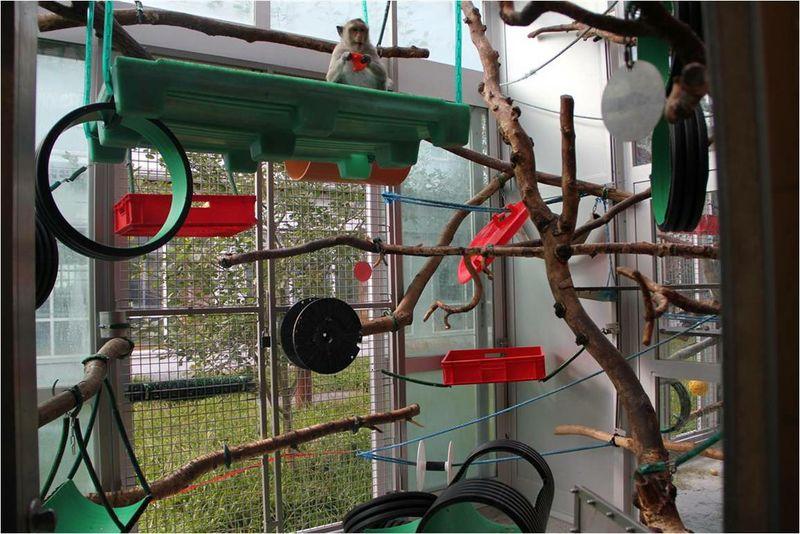
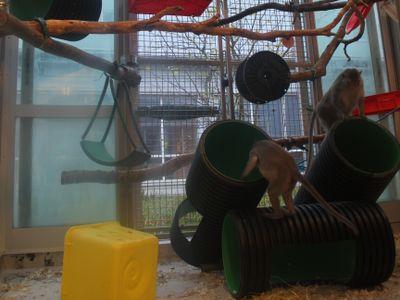
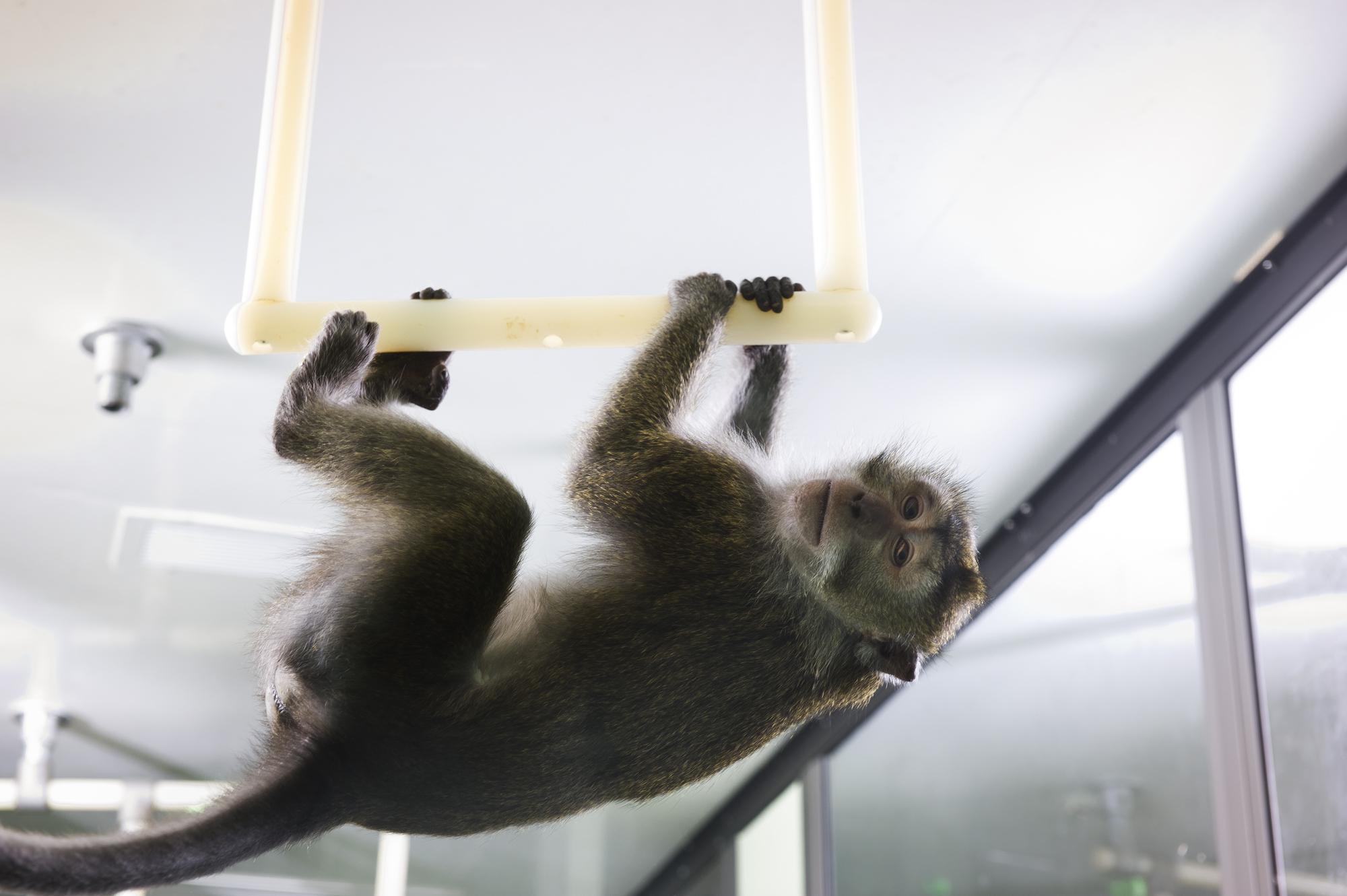
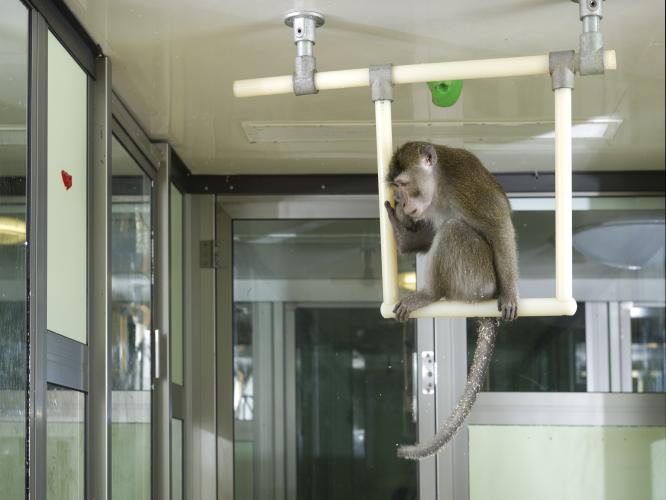
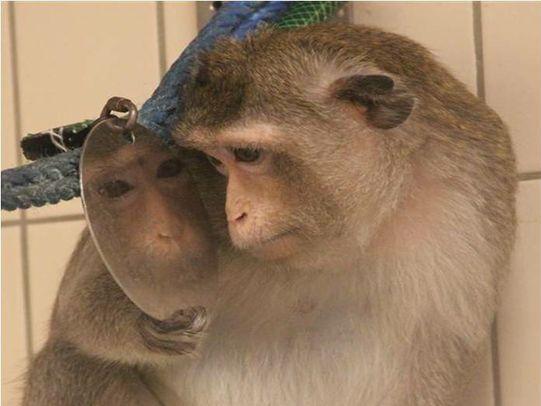
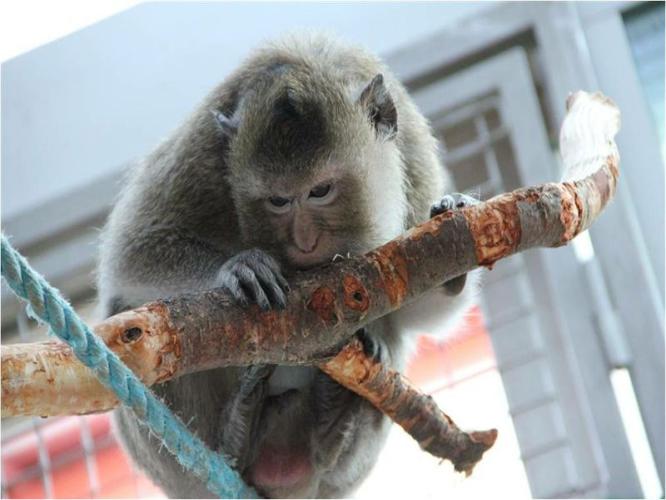
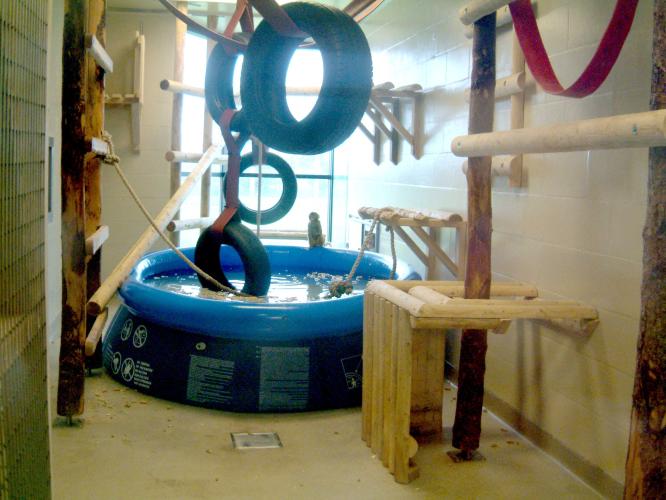
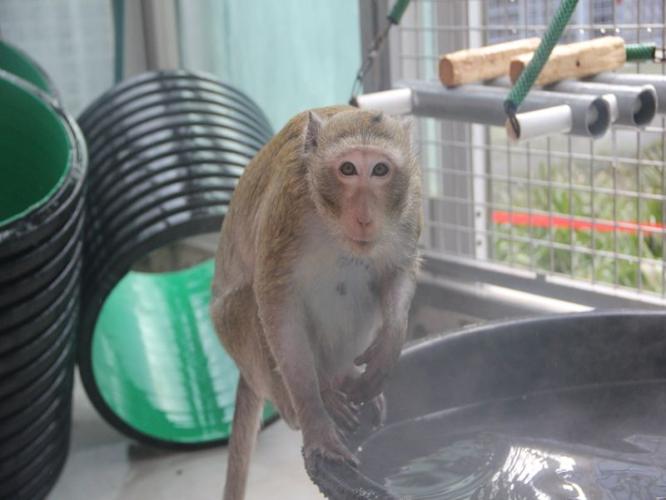
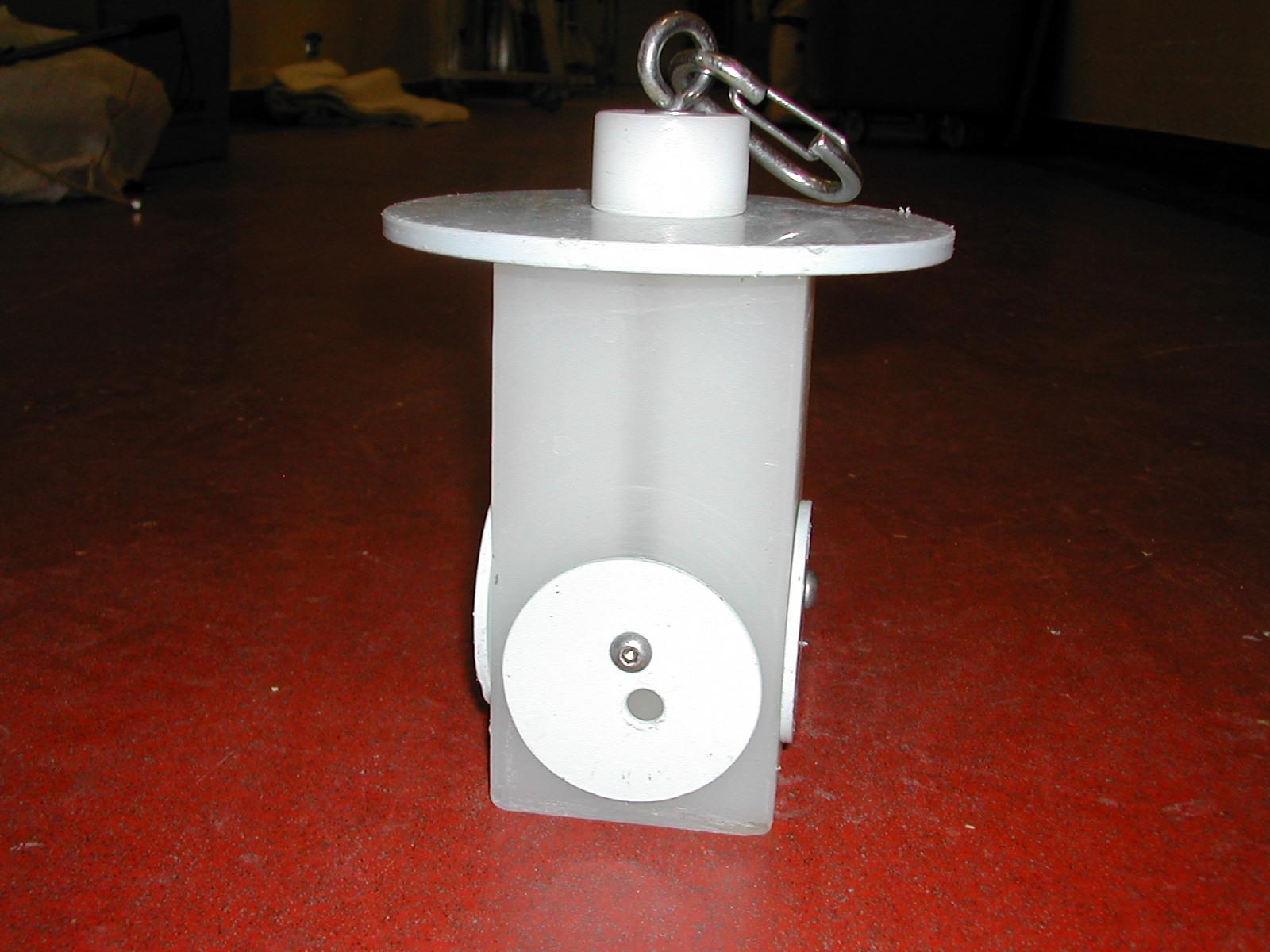
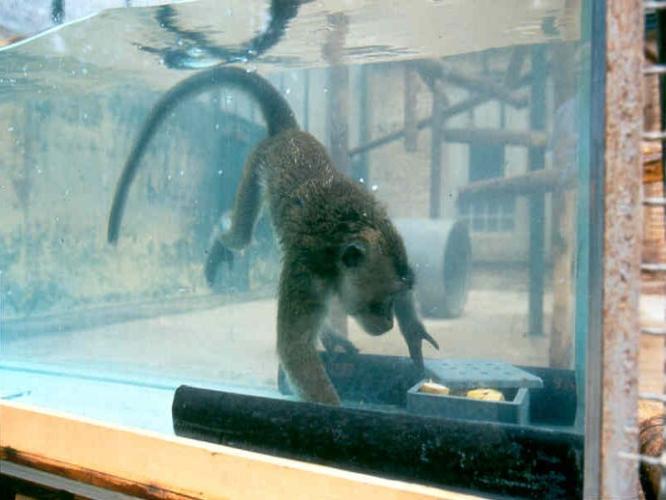
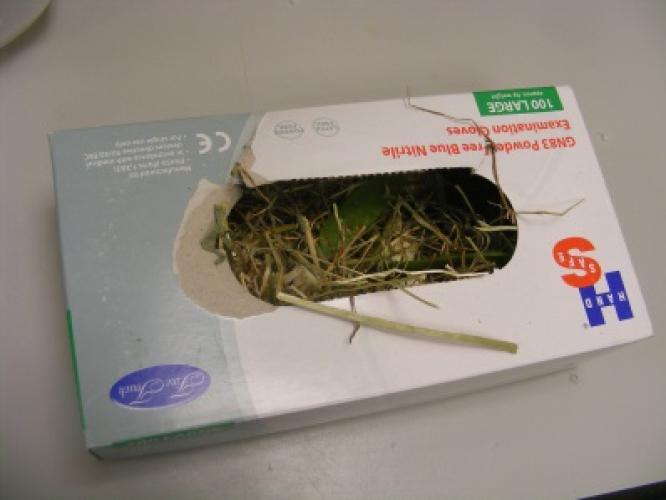
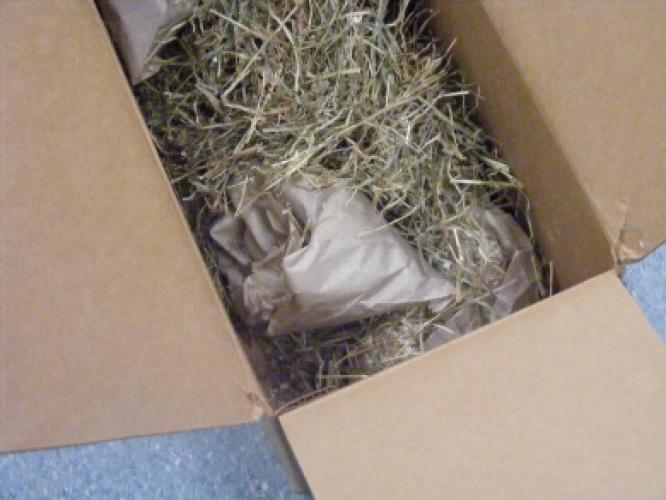
Social
Benefits of social housing
Social housing of macaques provides the opportunity for:
Macaque species naturally live in multi-male, multi-female groups of around 10-50 animals and this structure is ideal for breeding colonies. Grouping a single breeding male with several related females and their offspring (harem) is a common practice, as breeding can be controlled and lineages recorded. Stock groups of 10-20 small (2-3kg) macaques of the same sex are often housed together. Macaques used in experiments can be successfully maintained as groups in toxicology, immunology and neuroscience studies, even those with cranial or other implants [12,33,34].
Pair housing is not a natural social structure for macaques and will not work in all circumstances, so as a general rule it is always best to aim for larger groups. However, safe pair formation and subsequent pair-housing techniques have been developed for adult male and female rhesus, cynomolgus, stump-tailed and pig-tailed macaques [35-38]. When macaques are housed in pairs rather than larger social groups, widely spaced bars between the compatible pairs can increase perceived group size and social interactions without risking health or competition for food, or making identification and capture of animals more difficult [39].
Single housing should no longer be considered acceptable for macaques in the laboratory, with exceptions requiring compelling veterinary or scientific justification [12,40]. If single housing is necessary on the recommendation by a trained primate veterinarian or animal welfare officer, it should be for as short a period of time as possible; the isolated macaque should still be able to hear, see and smell group members [41]. Additional resources should be targeted to the care and welfare of such animals to compensate for the absence of social companions.
Managing social groups
A 2006 survey of US primate facilities revealed that 52% of rhesus macaques and 62% of cynomolgus macaques housed indoors were kept in single cages [42]. There is always concern housing non-human primates in groups in case conflicts between animals arise [43]. However, these can be managed effectively to allow the welfare benefits of social housing [44,45]. Factors contributing to the successful maintenance of harmonious social groups are summarized below [12].
Introductions to conspecifics
Plan introductions carefully:
Steps to implement:
Managing aggression
Where aggression occurs, assess the situation:
Steps to implement: